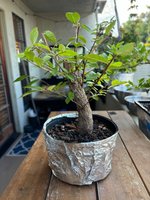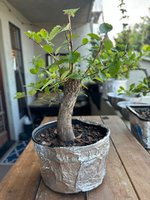zeejet
Mame
Still a first-year beginner at the time of this thread, but I figured I should start a few progress journals for some of the trees I’m optimistic about. All feedback is welcome - I’ve learned a lot at this point, but feel free to assume I know nothing!
Here is some context on this Wing Elm:
New buds have pushed and extension is already underway after about 2 weeks after receiving the tree. It is under full sun currently and seems to handle it just fine. Minor browning is most likely due to shipping stress.
Based on existing structure, I think this will end up being a fairly standard informal upright. The plan next spring is to repot to a larger container (most likely a 12"x12"x3.5" wood grow box - I also have some 15.75"x15.75"x5" Anderson flats but that might be a tad too big). Depending on root health, I may also select a front/leader and cut/carve the stub for more natural taper.


Here is some context on this Wing Elm:
- Obtained from Keith McKean (Bonsai by Design, Pocola, OK) via 99 Cent Bonsai Auctions on Facebook.
- Tree was collected by Keith in January 2024 and shipped to me (coastal San Diego - Zone 10b) in July 2024
- Trunk caliper at initial soil line is about 1.8”
- Previously chopped with a lot of shoots extending
- Soil appears to be almost entirely organic with a mix of bark and other components - drains very well.
New buds have pushed and extension is already underway after about 2 weeks after receiving the tree. It is under full sun currently and seems to handle it just fine. Minor browning is most likely due to shipping stress.
Based on existing structure, I think this will end up being a fairly standard informal upright. The plan next spring is to repot to a larger container (most likely a 12"x12"x3.5" wood grow box - I also have some 15.75"x15.75"x5" Anderson flats but that might be a tad too big). Depending on root health, I may also select a front/leader and cut/carve the stub for more natural taper.


